Melgar
Anti-Spam Agent
    
Posts: 2004
Registered: 23-2-2010
Location: Connecticut
Member Is Offline
Mood: Estrified
|
|
Closed-system thermoelectric cooling system
I posted a lovely, in-depth writeup of how I designed and build a thermoelectric cooling system for my condensers. And then hit submit while
disconnected from the internet. I could have installed Lazarus, but haven't yet on this computer. So pissed.
Guess I'll just show you these pictures and answer any questions you have.
It does motivate me a lot more to work on learning the feasibility of transitioning this forum to phpBB.
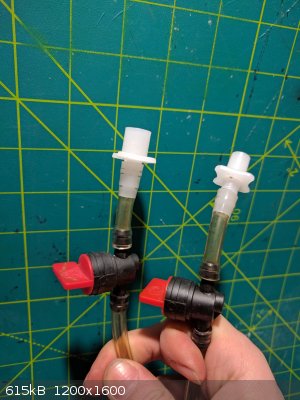 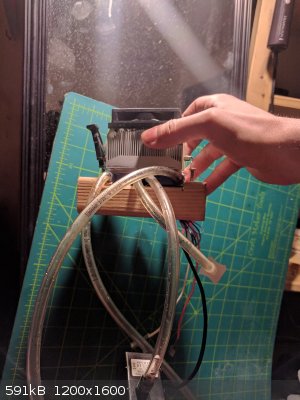 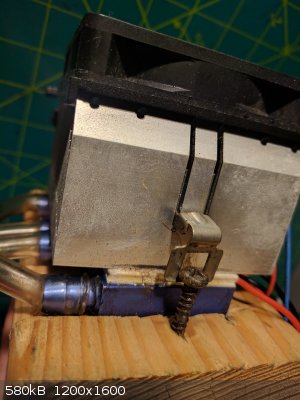 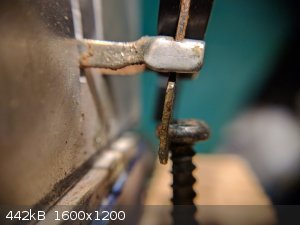
[Edited on 2/18/18 by Melgar]
The first step in the process of learning something is admitting that you don't know it already.
I'm givin' the spam shields max power at full warp, but they just dinna have the power! We're gonna have to evacuate to new forum software!
|
|
|
Sulaiman
International Hazard
    
Posts: 3558
Registered: 8-2-2015
Location: 3rd rock from the sun
Member Is Offline
|
|
I recently removed a small hot water 'radiator' from my home central heating system because it is no longer required,
Rather than dispose of it I've attached it to my chemistry workbench to cool condenser water before returning it to the reservoir,
in my case it saves on ice usage,
for your cooler it would mean fewer peltier elements, less power, smaller, cheaper.
ANY passive cooling before 'active' cooling helps, even just a long pipe or tube in air
Here is a photo of the radiator on my bench
(the bits of wood are to make a roof as I have 'discovered' that hot glassware + rain is a poor choice of combination 
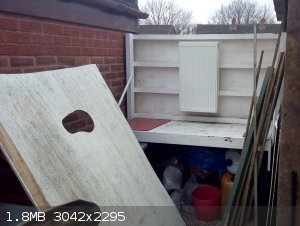
P.S. It should be obvious but I'll write it anyway,
this only applies where ambient temperature is significantly lower than the temperature of the water leaving your condenser(s)
also
the radiator/heat exchanger does not need to be physically proximate with the rest of your kit, it could be in a different room, or outside whilst you
are inside etc.
P.P.S. I allowed my family to continue thinking that I'm 'special' by not correcting the impression that I was trying to install outdoor central
heating 
[Edited on 19-2-2018 by Sulaiman]
CAUTION : Hobby Chemist, not Professional or even Amateur
|
|
|
wg48
National Hazard
   
Posts: 821
Registered: 21-11-2015
Member Is Offline
Mood: No Mood
|
|
I would think the cooling power of that is only a few tens of watts with say 20C difference between the faces of thermo cooler.
|
|
|
Mesa
Hazard to Others
  
Posts: 264
Registered: 2-7-2013
Member Is Offline
Mood: No Mood
|
|
Talking about relative temperature changes etc gives me an idea.
I've still got an old DIY phase change CPU cooling system in storage somewhere. It's essentially a gutted air conditioner pump and a (roughly) 3" x
3" copper heatsink wrapped in 1/4" copper pipe after the expansion valve.
It would pretty easily keep my old 3200+ at well below sub-zero temps under heavy load(I think equivalent to around 80watts TDP.) The design would be
useable with TEC's "as is" I think.
My internet is restricted atm and I can't access an online cheatsheet/calculator. Anyone know what temp differential would be possible with a 60watt
TEC with no thermal loading if the hot side is at -10*c?
Otherwise I'll look it up when I get back home in a few days.
|
|
|
Sulaiman
International Hazard
    
Posts: 3558
Registered: 8-2-2015
Location: 3rd rock from the sun
Member Is Offline
|
|
Do not forget that whether you are condensing or refluxing
the cooling power required is equal to the effective heating power,
so, taking water as an example (the worst case normally encountered)
2257 J/g at 80W cooling power = 80/2257 g/s = 127 ml per hour effective boil-up rate
- whether refluxed, condensed, or both.
I'm not that patient !
80W is enough to condense diethyl ether at up to 1.14 litres/hour - if the temperature is low enough.
CAUTION : Hobby Chemist, not Professional or even Amateur
|
|
|
wg48
National Hazard
   
Posts: 821
Registered: 21-11-2015
Member Is Offline
Mood: No Mood
|
|
Quote: Originally posted by Sulaiman  | Do not forget that whether you are condensing or refluxing
the cooling power required is equal to the effective heating power,
so, taking water as an example (the worst case normally encountered)
2257 J/g at 80W cooling power = 80/2257 g/s = 127 ml per hour effective boil-up rate
- whether refluxed, condensed, or both.
I'm not that patient !
80W is enough to condense diethyl ether at up to 1.14litres/hour - if the temperature is low enough. |
here is a perfprmave graph for a 50x50mm 15V version
Qc the cooling power and delta T is temperature beween the hot face and cold face.
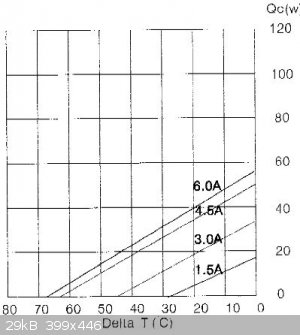
|
|
|
Sulaiman
International Hazard
    
Posts: 3558
Registered: 8-2-2015
Location: 3rd rock from the sun
Member Is Offline
|
|
waffle
just for experimenting I bought three TEC1-12706 or similar,
my plan was to use two to cool one for a two-stage heat pump,
(to cool a camera sensor for astrophotography for lower noise)
it worked (the cooler, not the cooler/sensor combo - due to ice)
but I should have calculated before buying,
for a two-stage cooler I think that five peltier elements are required,
one to pump heat from the subject to be cooled,
and four to pump the heat pumped and generated by the single TEC, to ambient.
I've given up on multi-stage cooling for now,
but as I now have my radiator for pre-cooling I may try all three in parallel
for c100W cooling power at c-20oC in-out difference,
but my gut feeling is that it would be much more efficient to add axial air fans to my radiator.
I'll know better when I get my super-dooper distillation rig up and running... maybe this year ? 
CAUTION : Hobby Chemist, not Professional or even Amateur
|
|
|
Melgar
Anti-Spam Agent
    
Posts: 2004
Registered: 23-2-2010
Location: Connecticut
Member Is Offline
Mood: Estrified
|
|
Quote: Originally posted by Sulaiman  | Do not forget that whether you are condensing or refluxing
the cooling power required is equal to the effective heating power, |
A common misconception, my dear Watson! In a typical distillation system, a great deal of heat is lost to the environment, whether through the
incomplete transfer to the flask or through the glassware.
I also use windshield wiper fluid as my coolant (mix of water and methanol) and leave it uncovered in its tank. It's then cooled before going to the
condenser. This system uses two 60-watt thermoelectric coolers, and I've discovered that the higher-power ones are much less efficient anyway. I can
drop the temperature 10-15˚C, which isn't that much, but good enough for most solvents that are liquid at room temperature.
If I need colder temperatures, I just dump a bunch of ice in the tank before I start distillation, then cover the tank. There is a large, noticeable
difference in its rate of melting based on whether the coolers are active or not. However, in this setup, I cool the water on its way back from the
condenser.
Copper-fin CPU cooling fans are actually quite cheap on eBay, if they mount on obsolete CPUs. I just used one I had laying around, and it's obviously
aluminum, but it does the job well enough.
The first step in the process of learning something is admitting that you don't know it already.
I'm givin' the spam shields max power at full warp, but they just dinna have the power! We're gonna have to evacuate to new forum software!
|
|
|
Sulaiman
International Hazard
    
Posts: 3558
Registered: 8-2-2015
Location: 3rd rock from the sun
Member Is Offline
|
|
Quote: Originally posted by Melgar  | Quote: Originally posted by Sulaiman  | Do not forget that whether you are condensing or refluxing
the cooling power required is equal to the effective heating power, |
A common misconception, my dear Watson! In a typical distillation system, a great deal of heat is lost to the environment, whether through the
incomplete transfer to the flask or through the glassware. |
Depends upon how you look at it Holmes 
I look at it as,
'effective heating power' accounts for any heat loss/ineficciency of the heater/mantle
'cooling power' includes heat pumps, ice, air-condenser etc.
basically all sources of transfer of heat to the environment.
e.g. if your fractionating column loses heat to the environment then it is also acting as an air condenser.
e.g. using heat pump + ice, the melting rate of the ice represents a significant cooling power.
Basic thermodynamics, heat in = heat out.
but I get where you are comming from,
the electrical heating power will typically be much more than the (heat pump + ice) cooling power,
but I would argue that for lower b.p. fluids, cooling power in your terms would be much more than heating power,
so it's not a 'universal' view.
EDIT: I forgot about the extra loss of heat required to cool the product from b.p. to collection temperature, but that does not change the basic
heating/cooling ballance under steady-state condtions,
but, to be pedantic, the fluid was originaly heated from starting temperature to b.p. and there will be excess heat in the pot and equipment at the
end of the distillation, which came from power input during warm up time
.. I've never calculated warm up time - just endured it.
I value your experience and knowledge and I certainly would not argue chemistry with you
(because I would lose! 
I just want to clarify things in my own mind as I have minimal experience but a big plan.
Almost exactly a year ago I showed a schematic of my intended distillation rig here,
it has gotten more complicated since then as I've learned a little
- still a long way to go,
and based on previous hobby projects, even when finally built, it will need more work
... continuously moving goalposts, little actual progress !
=======================================
I had virtually given up on the idea of thermoelectric cooling,
but now that I have incorporated the radiator into my design/workbench, TECs seem more viable,
so any measurements that you make are of direct interest to me.
Without actually testing and measuring I can't decide which is more likely to be 'the best'
1) use both radiator and TECs with their own heat sink to directly cool the cooling water
2) use the radiator to cool the TEC and use the TEC to cool the cooling water.
3) something so obvious that I have not considered it yet 
I suspect that it may depend upon the actual product b.p. range, so some plumbing flexibility may be required.
I really like the idea of not requiring ice as it allows some degree of unattended operation,
which is essential for me as I need to lie down a lot 
To add to my confusion, it is likely that later this year we will be replacing working fridge and freezer - I need a shed extension.
[Edited on 22-2-2018 by Sulaiman]
CAUTION : Hobby Chemist, not Professional or even Amateur
|
|
|
Melgar
Anti-Spam Agent
    
Posts: 2004
Registered: 23-2-2010
Location: Connecticut
Member Is Offline
Mood: Estrified
|
|
I waited too long, and now can't edit my first post anymore. Will have to make a new post with a proper writeup when I have more time.
I've just been guessing at specs here, but I'll add that if you can spare the money, the copper heat exchangers are the way to go. Aluminum is fine,
but copper is certainly superior.
The 60-watt size seems to be the most efficient, and they're very cheap from china. Higher-powered ones are less efficient and generate more waste
heat, which is very, very bad if your goal is cooling.
For a pump, this model has worked really well:
https://www.aliexpress.com/item/x/32696323866.html
There are fake "brushless" ones on eBay, but you know they're not really brushless if they operate on a wide voltage range, especially if it's 3-6VDC
or something in that range.
Everything is typically manufactured assuming 40mmx40mm blocks, since it's usually made for CPU cooling, so that's a plus. I used windshield washer
fluid as a coolant, because stuff won't grow in it, and it cleans up easily with no residue.
Cooling blocks can be had here:
https://www.aliexpress.com/item/x/32837834519.html
I got a bunch of nalgene quick connects on eBay for more than I wanted to pay ($40 or so for three bags of them) but I got a LOT. Then I put valves
inline with the flow to make it easier to switch condensers without siphoning out my coolant by mistake. I have matching connectors on all my
condensers too.
I also got one of those 360W 12V power supplies to power all my 12V stuff. It was maybe $20. It can power that, my LED lights, my vacuum pump, and a
few other things. Will take more pictures when I set up everything again, whenever that is. It was pretty neat when I had everything set up how I
wanted it.
The first step in the process of learning something is admitting that you don't know it already.
I'm givin' the spam shields max power at full warp, but they just dinna have the power! We're gonna have to evacuate to new forum software!
|
|
|
XeonTheMGPony
International Hazard
    
Posts: 1636
Registered: 5-1-2016
Member Is Offline
Mood: No Mood
|
|
Quote: Originally posted by Mesa  | Talking about relative temperature changes etc gives me an idea.
I've still got an old DIY phase change CPU cooling system in storage somewhere. It's essentially a gutted air conditioner pump and a (roughly) 3" x
3" copper heatsink wrapped in 1/4" copper pipe after the expansion valve.
It would pretty easily keep my old 3200+ at well below sub-zero temps under heavy load(I think equivalent to around 80watts TDP.) The design would be
useable with TEC's "as is" I think.
My internet is restricted atm and I can't access an online cheatsheet/calculator. Anyone know what temp differential would be possible with a 60watt
TEC with no thermal loading if the hot side is at -10*c?
Otherwise I'll look it up when I get back home in a few days. |
TEC's/Pelt's (Same thing different terms) Have a pretty fixed delta T of 20 to 25c -thermal conduction (They suck at that hence the inefficiency)
So -30 possibly.
I am making a vacuum cryotrap based on them and figure will need 3 to hit the desired temp, but will test one no load to see.
|
|
|
XeonTheMGPony
International Hazard
    
Posts: 1636
Registered: 5-1-2016
Member Is Offline
Mood: No Mood
|
|
A carnot cycle based unit will blow any tec system clean out the water, in the end I'll be making a auto-cascade system out of a small fridge
compressor for the vacuum trap, and I all ready have a water cooler compressor system for my condenser water system, as here winters get so cold they
will freeze the antifreeze into near syrup.
Simply find an old water cooler and use it whole just strip away the bulky plastic, side bonus if newer you get a 350 to 450w heating element as a
band most cases to use as a water bath heater!
|
|
|
Melgar
Anti-Spam Agent
    
Posts: 2004
Registered: 23-2-2010
Location: Connecticut
Member Is Offline
Mood: Estrified
|
|
I was looking into repurposing mini-fridges and old water coolers for this sort of thing, but ultimately, the resulting devices would be enormous.
The condensers are pretty much always huge, and it's not like it's practical to replace the condenser with something more compact. The advantages of
this sort of setup are that it's very small, easy to set up, and beats air cooling. Also, I can just add ice from my freezer to boost the effective
cooling power and efficiency. 
The first step in the process of learning something is admitting that you don't know it already.
I'm givin' the spam shields max power at full warp, but they just dinna have the power! We're gonna have to evacuate to new forum software!
|
|
|
Dr.Bob
International Hazard
    
Posts: 2658
Registered: 26-1-2011
Location: USA - NC
Member Is Offline
Mood: No Mood
|
|
Just take an old dorm fridge, put a water (or antifreeze) bucket with a copper coil in it in the center, fill the remaining space with plastic bottles
of water, set to coldest setting, which will eventually freeze the water, and then have a loop than uses the fridge full of ice as ballast. That
would be able to cool nearly any normal chemistry.
The same old technology is used to cool water to freezing in big tanks when electric rates are low and then air condition buildings during the day
when rates are higher on commercial clients.
|
|
|
XeonTheMGPony
International Hazard
    
Posts: 1636
Registered: 5-1-2016
Member Is Offline
Mood: No Mood
|
|
Quote: Originally posted by Melgar  | I was looking into repurposing mini-fridges and old water coolers for this sort of thing, but ultimately, the resulting devices would be enormous.
The condensers are pretty much always huge, and it's not like it's practical to replace the condenser with something more compact. The advantages of
this sort of setup are that it's very small, easy to set up, and beats air cooling. Also, I can just add ice from my freezer to boost the effective
cooling power and efficiency.  |
Actualy it is incredibly easy, if you have a map torch all you need to get is some 15% silphos for the refrigeration side of things, then 6 feet of
1/4 and 1/2 to make a coaxial condenser and water cool it!
then to recharge it just use an aspirator to suck it down, add some 134a, rinse and repeat 3 times then do a full on charge or get a local fridge shop
to do it for ya, most will do it for 50 bucks or so some may even do it free out of the novelty of the project.
I built that out of boredom in less then an hour! now given I have all the fancy tools and stuff but honestly any one of you could do the same over a
day or so of hunting materials, the water side is just regular old plumbing solder.
15%silphos may take a touch of work to find or ebay it, but it is a forgiving general purpose brazing rod for refrigeration. Just ensure joint is nice
and hot (glowing red)
[Edited on 23-3-2018 by XeonTheMGPony]
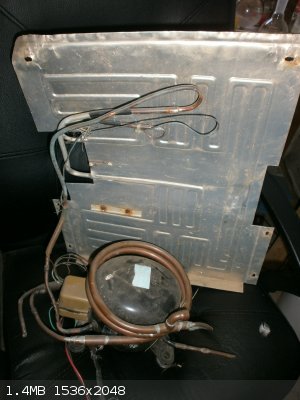
|
|
|
Ubya
International Hazard
    
Posts: 1232
Registered: 23-11-2017
Location: Rome-Italy
Member Is Offline
Mood: I'm a maddo scientisto!!!
|
|
Quote: Originally posted by XeonTheMGPony  | Quote: Originally posted by Melgar  | I was looking into repurposing mini-fridges and old water coolers for this sort of thing, but ultimately, the resulting devices would be enormous.
The condensers are pretty much always huge, and it's not like it's practical to replace the condenser with something more compact. The advantages of
this sort of setup are that it's very small, easy to set up, and beats air cooling. Also, I can just add ice from my freezer to boost the effective
cooling power and efficiency.  |
Actualy it is incredibly easy, if you have a map torch all you need to get is some 15% silphos for the refrigeration side of things, then 6 feet of
1/4 and 1/2 to make a coaxial condenser and water cool it!
then to recharge it just use an aspirator to suck it down, add some 134a, rinse and repeat 3 times then do a full on charge or get a local fridge shop
to do it for ya, most will do it for 50 bucks or so some may even do it free out of the novelty of the project.
I built that out of boredom in less then an hour! now given I have all the fancy tools and stuff but honestly any one of you could do the same over a
day or so of hunting materials, the water side is just regular old plumbing solder.
15%silphos may take a touch of work to find or ebay it, but it is a forgiving general purpose brazing rod for refrigeration. Just ensure joint is nice
and hot (glowing red)
[Edited on 23-3-2018 by XeonTheMGPony] |
i salvaged a fridge compressor from the street, it was used in a r600a system, i want to turn it into a small compact water cooler for my
distillations. i can't finish the project right now because i have just the compressor  gypsies will take anything made out of copper from garbage bins, so any fridges thrown away will be stripped out of capillary tube, filter
and any exposed copper tubing, but they are ignorant so they ignore the compressor (copper windings in the motor). i'll make a thread when i'll finish
this project (probably in a few years gypsies will take anything made out of copper from garbage bins, so any fridges thrown away will be stripped out of capillary tube, filter
and any exposed copper tubing, but they are ignorant so they ignore the compressor (copper windings in the motor). i'll make a thread when i'll finish
this project (probably in a few years ) )
thank you for the tip about 15%silphos, i'll look around for it
---------------------------------------------------------------------
feel free to correct my grammar, or any mistakes i make
---------------------------------------------------------------------
|
|
|
XeonTheMGPony
International Hazard
    
Posts: 1636
Registered: 5-1-2016
Member Is Offline
Mood: No Mood
|
|
and any can of butane will work well enough! Just vac the system down good, get a bullet filter dryer from EBay, and if you don't mind having to
recharge often a needle valve can be used instead of cap tube! only adjust when at room temp though and wrap the packing rubber in teflon allot.
|
|
|